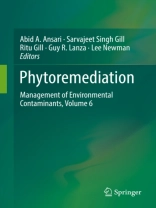This text details the plant-assisted remediation method, “phytoremediation”, which involves the interaction of plant roots and associated rhizospheric microorganisms for the remediation of soil contaminated with high levels of metals, metalloids, fuel and oil hydrocarbons, nano particles, pesticides, solvents, organic compounds and various other contaminants. Many chapters highlight and compare the efficiency and economic advantages of phytoremediation and nano-phytoremediation to currently practiced soil and water treatment practices.
Volume 6 of Phytoremediation: Management of Environmental Contaminants continues the series. Taken together, the six volumes provide a broad–based global synopsis of the current applications of phytoremediation using plants and the microbial communities associated with their roots to decontaminate terrestrial and aquatic ecosystems.
Innehållsförteckning
Preface.- Phytoremediation as green infrastructure.- Overview of phytoremediation applications.- Phyto and bioremedition strategies for soils and wastewaters.- Sorption release processes in soil.- Assisted phytoremediation technology with soil amendments.- Phytoextraction of metals from contaminated soils.- Phytoremediation of Boron-Contaminated Soils.- Phytoremediation and necrophytoremediation of petrogenic hydrocarbon-contaminated soils.- Phytoremediation of contaminated water.- PGPR assisted phytoremediation of heavy metal from municipal waste water.- Constructed Wetland technology to treat water contaminated with fuel and oil hydrocarbons.- Phytoremediation of waste and wastewater.- Fungi in the bioremediation of contaminants in water.- Phytoremediation of chromium polluted soil using plants in conjunction with microbes.- Microorganisms in the phytoremediation applications.- Phytoremediation using microbial assemblages in soil and water.- Microbe-assisted enhancement ofphytoremediation.- Phytoremediation of organic pollutants using aquatic and terrestrial plant species.- Phytoremediation of landfill leachates.- Nicotine contamination of agricultural crops.- Salix spp. in the phytoextraction of heavy metals.- Brassica spp. in the phytoextraction of heavy metals.- Dendroremediation.- The possibility of use of oilseeds plants and grasses for phytoremediation.- Woody species in phytoremediation applications for contaminated soils.- Nano-phytoremediation.- Impact of engineered nanoparticles on the phytoextraction efficiency of environmental pollutants.- Application of nano-phytoremediation technology for the remediation of soil polluted with pesticide residues and heavy metals.- Enhanced Phytoremediation of Contaminated Soil Using Engineered Nano-Materials.- Nano-phytoremediation applications for contaminated waters.- Index.
Om författaren
Abid A. Ansari is assistant professor in the Department of Biology, Faculty of Science, University of Tabuk, Saudi Arabia. Dr. Ansari’s research work is concerned with phytoremediation and eutrophication. Dr. Ansari has to his credit a number of research articles of national and international repute, eleven edited books, and a number of book chapters on varied aspects of his field of research. He has been awarded Scientist of the Year and Environmentalist of the Year by the National Environmental Science Academy, India, and Research Excellence by the University of Tabuk.
Dr. Sarvajeet Singh Gill is currently working as Professor (Asstt.) at Centre for Biotechnology, Maharshi Dayanand University, Rohtak, Haryana, India. Dr. Sarvajeet Gill’s research includes abiotic stress tolerance in crop plants, reactive oxygen species signaling and antioxidant machinery, gene expression, helicases, crop improvement, transgenics, nitrogen & sulfur metabolism and plant fungal symbiotic interactions. Together with Dr. Narendra Tuteja at ICGEB, New Delhi, he worked on plant helicases for abiotic stress tolerance. His research uncovered new pathways to plant abiotic stress tolerance and indicates the potential for improving crop production at sub-optimal conditions. Sarvajeet Gill has edited several books with Springer, Wiley, Elsevier, CABI etc and has a number of research papers, review articles, and book chapters to his name. Recently, Dr. Sarvajeet Gill conferred with INDIA Research Excellence & Citation Award – 2017 from Clarivate Analytics (Web of Science).
Dr. Ritu Gill is currently working as Professor (Asstt.) at Centre for Biotechnology, Maharshi Dayanand University, Rohtak, Haryana, India. Dr. Gill is working on phytoremediation, plant abiotic stress and molecular aspects of host-parasite relations. She has published a number of refereed journal articles, book chapters, books. She has been awarded with various researchfellowships along with the Young Scientist Award by the Indian Society for Parasitology.
Guy R. Lanza is a Research Professor in the Department of Environmental and Forest Biology, State University of New York. He also serves as Secretary of the International Expert Advisory Council at the University of Tyumen, Russia. He has previously worked at the Office of Environmental Sciences, Smithsonian Institution, Institute of Environmental Medicine, New York University, the Environmental Science programs at both the University of Texas (Dallas) and the University of Massachusetts (Amherst). His primary research interests are in environmental microbiology, phytoremediation, and aquatic ecology. He has published more than 80 refereed journal articles, book chapters, books, and technical reports. He is a Fellow of the American Academy of Microbiology, serves on the editorial boards of several microbiology journals and served as a Fulbright Scholar in Vietnam and Russia.
Lee Newman is an Associate Professor in the Department of Environmental and Forest Biology, State University of New York. Dr. Lee’s primary research interests are in phytoremediation and interactions between plants and endophytic bacteria. She has published a number of refereed journal articles, book chapters, books, and technical reports.












